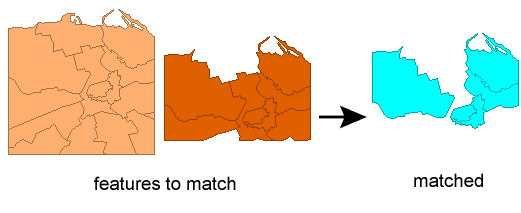
Detects features that are matches of each other. Features are declared to match when they have matching geometry, matching attribute values, or both. A list of attributes which must differ between the features may also be specified.
The Match Geometry parameter controls whether 2D or 3D (or NO) geometry must be the same before a match is declared. FULL makes sure 3D, measures, and Geometry Traits all match.
When comparing raster geometries:
When comparing surface and solid geometries: 2D behaves the same way as 3D, that is, Z values will also be compared.
When comparing point cloud geometries:
In conjunction with Selected Attributes, this parameter controls which attributes of input features must have the same value before a match is declared.
This parameter is applicable when Attribute Matching Strategy is set to Match Selected Attributes or Match All Except Selected Attributes, and specifies which attributes to match, or exclude from the match, depending on the matching strategy chosen
Controls which attributes that are part of the input feature must have different values before a match is declared. The values from all attributes matching the regular expression are concatenated together and compared to determine a match.
If this parameter is set to As Attribute Value, an attribute will be considered different for two features when one feature contains the attribute with a blank value and the other feature does not contain the attribute at all. This affects both Matching Attributes and Differing Attributes.
If this parameter is set to yes, then the order of points in line and area features will be ignored.
Composition differences between paths and lines will be ignored. True arcs and ellipses versus their stroked polygon equivalents will be ignored in Aggregates, Polygons, Donuts, Paths, and all other multis. When comparing raster geometries, only the extents are compared.
This parameter determines how close together interior vertices must be in order for them to be declared a match. Note that the start and end points of features should be LESS than the parameter value. That is, if two vertices are 2 meters apart, and the parameter is set to 2, they will not match. This value is optional.
When geometry is being matched, Extra Vertex Tolerance can allow for extra vertices along line segments. A value of 0 means that no such extra vertices are permitted. A nonzero value controls how close any extra vertices must be to the line connecting the adjoining matching vertices.
Note: For surface and solid geometries, Interior Vertex Tolerance and Extra Vertex tolerance are ignored and assumed to be 0.0. This transformer does not support surfaces or solids in the input if the Lenient Geometry Match is set to yes.
An ID is added to each set of matched features so that it is possible to build a relationship between them if required.
If provided, a list of all attributes from features contributing to each SINGLE_MATCHED output will be constructed with this name.
The ChangeDetector provides an alternate (but less general) approach which may be more convenient for certain applications.

About Transformer Parameter Options
Search for samples and information about this transformer on FMEpedia.